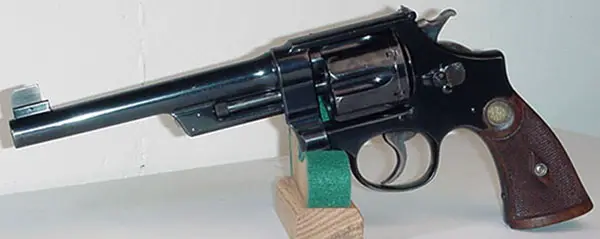|
Smith & Wesson�s Finest Revolver: The Triple-Lock By David Tong  Just a scant eight years after Smith & Wesson came out with the seminal "K" (medium) frame Hand Ejector of 1899, their most successful and most produced DA revolver of all time, S&W topped themselves with the introduction of the "N" (large) frame .44 Hand Ejector First Model New Century, also known as the "Triple Lock." The Triple Lock revolver was never made in the quantities of the smaller K-frame. There is no way it could have been. S&W was the first to consider the idea of providing a lock on either end of the cylinder axis pin. Obviously, if one has an �axle,� it is best to have it supported at both ends, so S&W fitted a spring-loaded plunger into an integrally-machined lug to hold the front of the ejector rod in alignment with the cylinder pin at the breech end of the cylinder. The Company thought that it might be better still if the swing-out cylinder�s crane could also provide some stability, so a precisely fitted third lug, left case-hardened in the white, was placed to bear against the frame where the crane closed. Hence the name Triple Lock. No other revolver had all three points held in such solid alignment. (The "locks" in question are not what locks the cylinder in place, chamber indexed with the barrel, when a revolver is fired; that is the bolt. Dave is writing about the points that support the cylinder and keep it correctly aligned with the frame when it rotates. Since the hand tries to rotate a S&W cylinder out of the frame every time the revolver is cocked, extra support is required to keep the cylinder aligned with the barrel. Colt cylinders rotate into the frame and the hand forces the cylinder tight against the bolt, so double and triple cylinder latches would be superfluous on a Colt DA revolver. -Editor.) This revolver also featured a shroud, integral with the barrel, to protect the ejector rod. The price was a princely $21 when introduced, which was real money at the time. The Triple Lock was initially available only with fixed sights, in 4�, 5�, 5-��, 6� and 6-�� barrel lengths. Later, Smith introduced a Target Model with a screw adjustable rear sight and a higher, pinned front sight. S&W had developed a series of .44 caliber (actually using .429� bullets) black powder cartridges for their earlier single-action, top-break, simultaneous ejection revolvers (the American, Russian and Schofield). The Company introduced the .44 S&W Special cartridge, a lengthened version of the earlier .44 Russian, in the Triple Lock. The cartridge became known for its accuracy and mild recoil. Some of both were probably due to its original loading, which launched a 246 grain LRN bullet at just 750 fps, quite similar to that of the British .455 Webley and comparable several other anemic turn of the century revolver rounds. Available calibers eventually included not only the .44 Special, but also .38-40 Winchester, .44-40 Winchester, .455 Eley, .455 Webley Mk II and potent .45 Colt. Due to WWI, the British ordered many thousands of Triple Lock revolvers. The mud of France proved too much for the tight tolerances of the crane lock and the cost of manufacture of the revolver could not be justified, especially for the mild power of the .455 British service cartridge. The subsequent Second Model .44 Hand Ejector disposed of both the third lock as well as the ejector rod shroud, for a mere $2 reduction in price. Later still, the Third Model re-introduced the ejector rod shroud that is still part of S&W�s line of N frame revolvers to this day, most of which have been chambered for the .357, .41 and .44 Magnum cartridges. The Triple Lock was built between 1907 and 1915. Only 15,375 were built and, needless to say, examples in good condition are prized and pricey collector�s item today. The First Model is indeed a finely finished revolver. The author once owned a 6-�� Target Model in factory nickel finish, with original stocks. The double-action trigger pull was very smooth, if fairly heavy by today�s custom-tuned standards, while the single-action release stood at about four pounds. Again, pretty heavy by later target revolver standards, but creep free and clean. The sights do not have spring-loaded click detents, but are moved by very fine pitch machine screws. The rear sight is the famous S&W spring steel leaf, but these early sights were polished level with the top strap of the frame when the sight was lowered all the way down. The hairline split between the top strap and the sight was just one indication of the exterior quality. Internally, while I never fully detail stripped the revolver, I did remove the sideplate to do a more thorough cleaning and lubrication. It featured extremely smooth internal machining of the frame, sideplate, rebound slide and hand, with highly polished surfaces throughout. Both the trigger and hammer had S&W�s usual color case hardening and offered a tough, long-wearing bearing surface to maintain trigger quality over many thousands of cycles. The single leaf mainspring was heat blued and polished. Externally, the revolver had lots of remaining factory nickel, with some flaking and holster wear that made for a memorable shooter. I wish I had been prescient enough to realize the need to photograph such a historic arm while I was its temporary caretaker. I hope that its new owner, whoever he or she might be, is enjoying it as much as I did. |